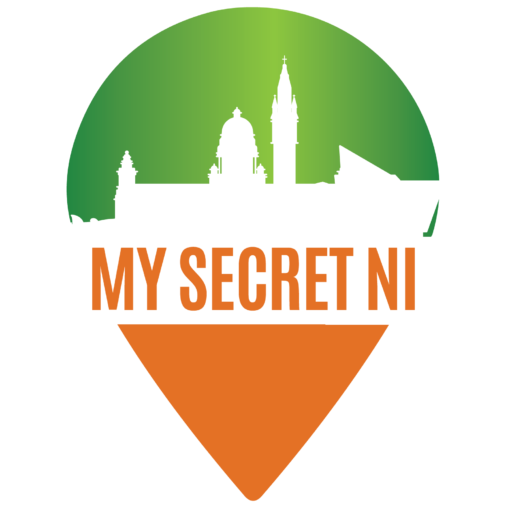Exploring the Flags of Northern Ireland
Northern Ireland is a region steeped in history, culture, and tradition. One aspect that defines its identity is the flags representing the region and its people. Over the centuries, various flags have been used to symbolize different aspects of Northern Ireland’s history and culture. In this article, we will explore the different flags of Northern Ireland and their significance.
A Brief History of Northern Ireland Flags
The story of the Northern Ireland flag is one of diversity and complexity. The earliest flags used in the region date back to the medieval period, and some are still in use today. However, most flags we associate with Northern Ireland today were created in the 20th century, marking significant events and moments in the region’s history.
The Union Jack and its Significance
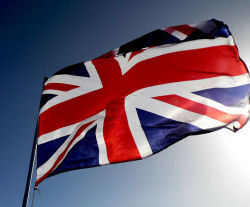
The Union Flag is the most recognisable flag in the world and represents the United Kingdom. In Northern Ireland, the Northern Ireland flag is a symbol of British identity and sovereignty. It features a combination of the cross of St. George, the patron saint of England, St. Andrew, the patron saint of Scotland, and the cross of St. Patrick, the patron saint of Ireland.
The Union Flag has been flown in Northern Ireland as the national flag and official flag since the Act of Union in 1800, which united Ireland with Great Britain. During the Troubles, the flag became a source of controversy, with some nationalists and republicans feeling that it represented a foreign power imposing its rule on Ireland.
Despite this controversy, the Union flag remains an important symbol of British identity in Northern Ireland. It is often flown at official events and on public buildings to represent the region’s connection to the United Kingdom.
The Ulster Banner: A Controversial Symbol
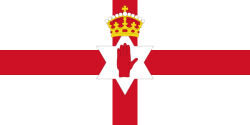
The Ulster Banner, also known as the official Northern Ireland flag, was introduced in 1953 as the official flag of Northern Ireland and represent Northern Ireland government. The flag features a red cross with a six-pointed star in the centre and a crown on top. The red hand of Ulster, a symbol of Northern Ireland, is also featured on the flag.
Northern Ireland’s government flew the Ulster Banner until the region’s power-sharing agreement in 1972. After violence erupted during The Troubles, the flag became controversial. Many nationalists and republicans viewed it as a symbol of unionist domination and refused to recognize it as the region’s official flag.
Despite its controversial history, the Ulster Banner remains an important symbol of Northern Ireland’s identity for many unionists and loyalists. It is often flown at parades and other events to represent their regional connection.
The Ulster Flag
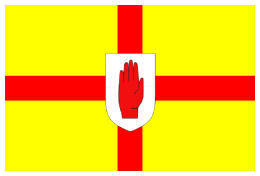
The Ulster Flag is one of the four provincial flags of Ireland; this particular flag is a red cross on a yellow background, with a red hand on a shield in the centre. This is similar to the Northern Ireland Flag, with the flag of Northern Ireland having a white field instead of yellow. The origins of this design are shrouded in mystery, but there are many theories as to its meaning and significance. One popular theory is that the flag was inspired by the Red Hand of O’Neill, a legendary figure in Irish mythology who is said to have cut off his own hand to win a race to the land of Ulster.
The Saint Patrick’s Saltire: A Historical Connection
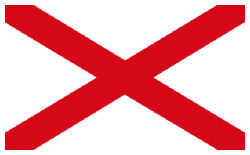
The Saint Patrick Saltire is a red saltire on a white background representing Ireland’s patron saint. The flag is closely associated with Irish nationalism and is often flown at St. Patrick’s Day celebrations.
The flag connects to Northern Ireland through its patron saint, Saint Patrick, who is said to have brought Christianity to the region. The flag is not commonly flown in Northern Ireland, with many people viewing it as a symbol of the Republic of Ireland rather than Northern Ireland.
Despite this, the Saint Patrick’s Saltire remains an important symbol of Irish identity in Northern Ireland. It is often flown by nationalists and republicans to represent their connection to the island of Ireland.
In conclusion, the flags of Northern Ireland represent a complex and diverse history. Each flag represents a different aspect of the region’s identity and history, from the Union Jack to the Ulster Banner and the Saint Patrick’s Saltire. Despite their controversial histories, these flags remain essential symbols of Northern Ireland’s past, present, and future.
The Flags of Northern Ireland’s Counties
The counties of Northern Ireland each have their own flags, representing the unique history and culture of the region. The flags are not only a symbol of the county they represent but also a representation of the people who live there. Let us take a closer look at each one:
County Antrim
The flag of County Antrim features a red hand on a white background. The red hand symbolises Ulster and has been used in the region for centuries. County Antrim is known for its stunning coastline, including the Giant’s Causeway, a UNESCO World Heritage Site. The county is also home to the historic city of Belfast, which was once the industrial powerhouse of Ireland.
County Armagh
The flag of County Armagh features a gold Celtic cross on a green background. The cross represents Christianity, while the green background represents the region’s lush countryside. County Armagh is known as the “Orchard County” due to its abundance of apple orchards. The county is also home to the ancient city of Armagh, which was once the ecclesiastical capital of Ireland.
County Down
The flag of County Down features a St. Patrick’s cross with a gold castle and two goats on a green background. The castle and goats represent the historic town of Downpatrick and the surrounding areas. County Down is known for its natural beauty, including the Mourne Mountains, which inspired C.S. Lewis to create the magical world of Narnia. The county is also home to the seaside town of Newcastle, which is a popular destination for tourists.
County Fermanagh
The flag of County Fermanagh features a black and white checkerboard pattern with a red hand in the centre. The checkerboard pattern represents the region’s Gaelic heritage, while the red hand represents Ulster. County Fermanagh is known for its stunning lakes, including Lough Erne, which is a popular destination for boating and fishing. The county also has the Marble Arch Caves Global Geopark, a UNESCO Global Geopark.
County Londonderry
The flag of County Londonderry features a red field with a gold harp in the centre. The harp symbolises Ireland and has been used in various iterations throughout the region’s history. County Londonderry is known for its historic walled city of Derry, which played a key role in the Troubles. The county is also home to the stunning Causeway Coast, which includes the Mussenden Temple and the Carrick-a-Rede Rope Bridge.
County Tyrone
The flag of County Tyrone features a white star on a blue background. The star represents the county’s position as the centre of Ulster and its bright future. County Tyrone has a rich history, including the Hill of The O’Neill and Ranfurly House Arts and Visitor Centre. The county is also home to the Ulster American Folk Park, which tells the story of emigration from Ulster to America.
Political and Cultural Flags in Northern Ireland
Northern Ireland has a complex history and culture; its flags reflect this diversity. The region is home to both nationalists who seek a united Ireland and unionists who wish to remain part of the United Kingdom. The flags of Northern Ireland are often used as symbols of political and cultural identity.
The Irish Tricolour: A Symbol of Nationalism
The Irish Tricolour, also known as the National Flag of Ireland or simply The Irish Flag, is a tricolour of green, white, and orange. The flag was first flown during the Young Irelander Rebellion of 1848 and was later adopted as the national flag of the Republic of Ireland. The green represents the Irish nationalist cause, the orange represents the Protestant minority in Ireland, and the white represents peace between the two communities.
In Northern Ireland, the Irish Tricolour is closely associated with Irish nationalism and the desire for a united Ireland. Nationalists and Republicans often fly it as a symbol of their political aspirations. However, it is also sometimes seen as a provocative symbol by unionists and loyalists, who view it as challenging their British identity.
The Red Hand of Ulster: A Loyalist Emblem
The Red Hand of Ulster is a symbol used in the region for centuries. It is said to represent the hand of the mythical Irish king, Ulster, who cut off his own hand to be the first to touch the land of Ireland. The Red Hand of Ulster is often associated with unionism and loyalism in Northern Ireland.
In recent decades, unionists and loyalists have adopted the Red Hand of Ulster as a symbol of their loyalty to the United Kingdom and Northern Ireland’s place within it. It is often seen on flags and banners at loyalist parades and demonstrations.
The Starry Plough: A Flag of Socialism
The Starry Plough is a flag of socialism and is associated with the Irish Republican Socialist Party. The flag features a plough surrounded by stars and a red field. It was designed initially by Irish socialist James Connolly in 1910 and was later adopted by the Irish Citizen Army during the Easter Rising of 1916.
In Northern Ireland, the Starry Plough is often flown by socialists and republicans who support the idea of a united Ireland and a socialist society. It is sometimes seen as a controversial symbol by unionists and loyalists, who view it as a threat to their British identity.
The Sunburst Flag: A Republican Icon
The Sunburst Flag is a flag of Irish republicanism and features a sunburst of gold on a blue field. The Irish Republican Army first used the flag in the early 20th century, and is often associated with the struggle for Irish independence.
In Northern Ireland, the Sunburst Flag is flown by republicans and nationalists who support the idea of a united Ireland and the establishment of a republic. It is often seen as a provocative symbol by unionists and loyalists, who view it as challenging their British identity.
The Flag Of The Ulster Nationalists
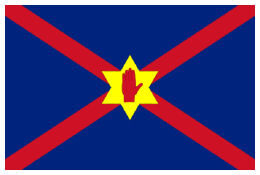
This flag is often seen around Unionist and Loyalist areas of Northern Ireland. It is the flag of a movement that wants complete independence from the UK.
Conclusion
In conclusion, the flags of Northern Ireland represent the rich history and culture of the region. From the Union Jack and Ulster Banner to the county flags and political and cultural flags, each has its unique story and significance. Understanding the meaning behind these symbols is key to understanding the complexities of Northern Ireland’s past and present.
